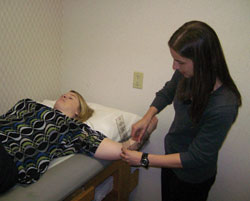External rotation, number of pitches affects shoulder injury rates in softball pitchers
Investigators noted national guidelines for fast pitch softball may help reduce in-season shoulder injuries.
Compared to uninjured pitchers, injured softball pitchers have less external rotation in their dominant arm and throw in more practices, according to investigators from New York.
“Shoulder injury is associated with less external rotation in the pitching arm and increased number of practices pitched,” Kristen L. Thomas, MD, said. Shoulder injuries sustained by the pitchers included SLAP tears, biceps tendonitis and rotator cuff tendonitis.
At the American Academy of Orthopaedic Surgeons 2012 Annual Meeting in San Francisco, Thomas said she and her colleagues studied these injuries because of their increased incidence among high school and collegiate fast-pitch softball players. Some research shows 45% of underhanded pitchers had an injury that resulted in time lost, she said.
Grading shoulder injury severity
“In softball, pitching is the number one cause of shoulder injury lasting more than 9 days, and 30% of the injuries reported were recurrent injuries and were mostly bicipital and rotator cuff tendonitis,” Thomas said.
She and colleagues studied 50 pitchers from NCAA Division I, II and III softball teams. They collected pitching logs from six of the 14 softball teams that participated in the study.

Figure 1. To measure each pitcher’s range of motion, Thomas used a goniometer, as shown here.
Image: Thomas KL
Researchers categorized the severity of each pitching injury as grade 1, an injury without time lost; grade 2, an injury with time lost; and grade 3, a season-ending injury. Of those studied, 20 pitchers had grade 1 injuries, six pitchers had grade 2 injuries and no pitchers had a grade 3 injury, according to Thomas.
She examined the players prior to the start of the season. Before the season began, each player had their range of motion measured with a goniometer and shoulder strength measured with a dynamometer. During the season, Thomas collected weekly injury surveys from the players and pitch logs from the coaches. At the end of the season, she categorized the players into injured and noninjured groups.
Need for pitching guidelines
Thomas and colleagues found range of motion of the shoulder was associated with a shoulder injury. They discovered injured pitchers had 103· external rotation, average, in their dominant arm, which was significantly less than in noninjured pitchers, whose external rotation was 116°.
Another factor associated with shoulder injury rates: how many practices were pitched. Injured players tended to pitch more games and had a higher pitch count than noninjured players. Noninjured pitchers threw 840 pitches per season and injured players threw almost double that, according to Thomas.
“Although there is a large difference in the number of pitches thrown between the injured and non-injured players, it was not statistically associated with injury,” she said. “I think that was due to the limited number of players with recorded pitch counts.”
Thomas noted that a fast-pitch softball pitching guideline, which is not currently in use due to the belief that underhanded pitching does not create stress on the shoulder, could possibly prevent injury in fast-pitch players.
“Pitch count and injury rate need to be further investigated to see if national pitching guidelines are indicated to help prevent shoulder injuries,” she said. – by Jeff Craven
Reference:
- Thomas K, Cuomo F, McCann PD. Effect of pitch count, shoulder motion and strength on risk of injury in collegiate softball pitchers. Paper #466. Presented at the American Academy of Orthopaedic Surgeons 2012 Annual Meeting. Feb 7-11. San Francisco.
For more information:
- Kristen L. Thomas, MD, can be reached at Finger Lakes Orthopedic Surgery, 300 Hoffman St., Elmira, NY, 14905; 607-734-4110; email: kristent22@gmail.com.
- Disclosure: Thomas has no relevant financial disclosures.

